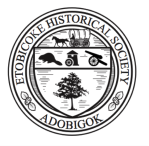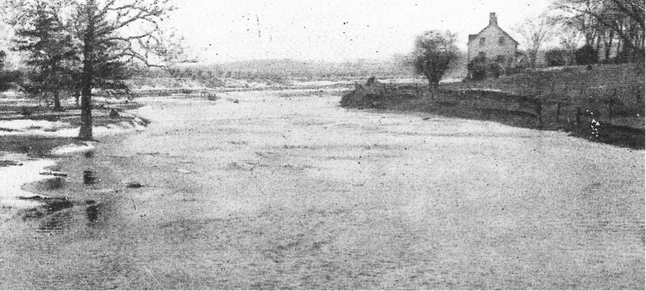Silverthorn Family Left a Long Legacy in Etobicoke and Beyond
Silverthorn Avenue. Silverthorn Park. Silverthorn Bush Drive. Mill Road. Cherry Hill Public School. These are just a few of many places in the Toronto Area named for the pioneer Silverthorn family.
Born in New Jersey in 1762, John Silverthorn, his wife Esther and their son Joseph moved to Niagara in 1786 where nine more children were born. In 1807, Joseph and his wife Jane moved to Toronto Township (Mississauga) where they had been granted land at Dundas Street and Cawthra Road. They called their home Cherry Hill, and it still stands as a restaurant on Silver Creek Blvd.
In 1811, John and Esther moved to a 120 hectare property in Etobicoke, east of Etobicoke Creek, north of Dundas Street. They built a large log cabin by the river, naming their new home “Mill Farm.” John and son Aaron built saw and grist mills just north of Dundas, and dammed the river to create a mill pond. They also built a bridge over the creek and opened a road from Burnhamthorpe to Dundas to facilitate travel to their mills. The bridge was washed out during Hurricane Hazel, but the north section of this road is still called Mill Road today. A village called “Silverthorn’s” developed along Dundas on both sides of the creek, later renamed “Summerville.”
When the War of 1812 broke out, sons Joseph, Thomas and Aaron all served in the York Militia. Thomas was wounded and unable to farm after the war, so he opened Summerville’s first inn in 1818. Aaron married Mary Custead in 1813 and they had eight children. Sadly, cholera epidemics in the 1830s claimed two of their daughters and Aaron’s brother, Thomas. Aaron continued to live at Mill Farm and work alongside his father, so he inherited the property when John died in 1846.
A shrewd businessman, Aaron invested in properties which later made money for his descendants, including land where Sherway Gardens and Queensway Hospital are today and land northeast of St. Clair and Old Weston Road where Silverthorn Avenue is located.
The original Silverthorn log house burned down in 1869, and the family immediately replaced it with the stucco over frame dwelling that you see on the right in the above photo.
Aaron passed away in 1872, predeceased by his wife Mary in 1853. They are buried in Dixie Union Cemetery in Mississauga where John Silverthorn had played a key role in founding Dixie Union Church in 1810. Read more about the Silverthorn Family HERE.
Researched & Written by Denise Harris, originally published by the Etobicoke Guardian and reprinted with permission.
Born in New Jersey in 1762, John Silverthorn, his wife Esther and their son Joseph moved to Niagara in 1786 where nine more children were born. In 1807, Joseph and his wife Jane moved to Toronto Township (Mississauga) where they had been granted land at Dundas Street and Cawthra Road. They called their home Cherry Hill, and it still stands as a restaurant on Silver Creek Blvd.
In 1811, John and Esther moved to a 120 hectare property in Etobicoke, east of Etobicoke Creek, north of Dundas Street. They built a large log cabin by the river, naming their new home “Mill Farm.” John and son Aaron built saw and grist mills just north of Dundas, and dammed the river to create a mill pond. They also built a bridge over the creek and opened a road from Burnhamthorpe to Dundas to facilitate travel to their mills. The bridge was washed out during Hurricane Hazel, but the north section of this road is still called Mill Road today. A village called “Silverthorn’s” developed along Dundas on both sides of the creek, later renamed “Summerville.”
When the War of 1812 broke out, sons Joseph, Thomas and Aaron all served in the York Militia. Thomas was wounded and unable to farm after the war, so he opened Summerville’s first inn in 1818. Aaron married Mary Custead in 1813 and they had eight children. Sadly, cholera epidemics in the 1830s claimed two of their daughters and Aaron’s brother, Thomas. Aaron continued to live at Mill Farm and work alongside his father, so he inherited the property when John died in 1846.
A shrewd businessman, Aaron invested in properties which later made money for his descendants, including land where Sherway Gardens and Queensway Hospital are today and land northeast of St. Clair and Old Weston Road where Silverthorn Avenue is located.
The original Silverthorn log house burned down in 1869, and the family immediately replaced it with the stucco over frame dwelling that you see on the right in the above photo.
Aaron passed away in 1872, predeceased by his wife Mary in 1853. They are buried in Dixie Union Cemetery in Mississauga where John Silverthorn had played a key role in founding Dixie Union Church in 1810. Read more about the Silverthorn Family HERE.
Researched & Written by Denise Harris, originally published by the Etobicoke Guardian and reprinted with permission.

